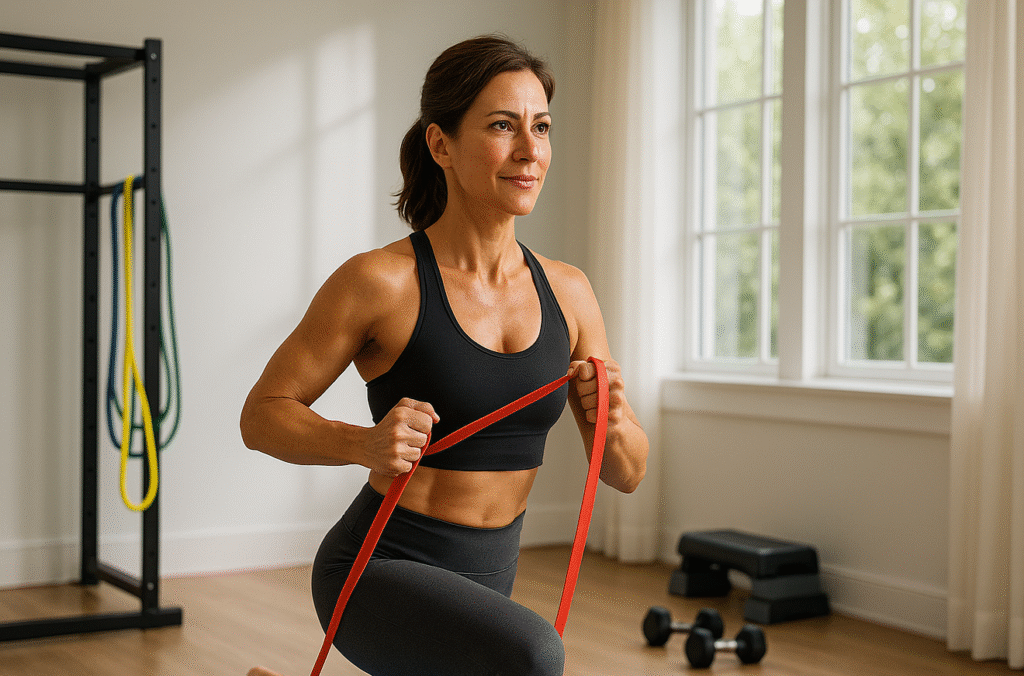As we navigate our 40s and beyond, the fitness rules we once lived by can start to feel… different. The high-impact, go-hard-or-go-home workouts that once sculpted and energized us may now leave us feeling drained, sore, or even lead to frustrating weight loss plateaus. This isn’t a sign of defeat; it’s a signal for evolution. For women over 40, the key to a vibrant, strong, and resilient body isn’t about pushing harder—it’s about training smarter.
The secret lies in a powerful, synergistic approach that combines the muscle-building magic of resistance bands, the mindful flexibility of yoga, and a more intelligent application of High-Intensity Interval Training (HIIT). This trifecta is uniquely suited to address the physiological shifts of perimenopause and menopause, helping you build lean muscle, boost your metabolism, and manage stress, all while carving out a physique that feels as good as it looks.
The Shifting Landscape: Why Your Old Workout Might Be Working Against You After 40
If you feel like your body has started playing by a new set of rules, you’re right. The hormonal fluctuations that begin in our late 30s and accelerate through our 40s change the way our bodies respond to exercise, stress, and nutrition.
The Hormonal Factor: Understanding Perimenopause, Menopause, and Cortisol
The two main players in this shift are estrogen and cortisol. As estrogen levels naturally decline during perimenopause and menopause, our bodies can experience a cascade of changes:
- Loss of Muscle Mass: Estrogen plays a role in muscle synthesis, so as it drops, maintaining and building lean muscle becomes more challenging. This is critical because muscle is our metabolic engine—the more we have, the more calories we burn at rest.
- Decreased Bone Density: Estrogen is also crucial for bone health. Its decline can accelerate bone loss, increasing the risk of osteoporosis.
- Increased Cortisol Sensitivity: This is the big one. Cortisol is our primary stress hormone. While essential in small doses, chronically elevated levels—triggered by high-stress workouts, poor sleep, or life’s daily pressures—can signal your body to store fat, particularly around the abdomen. Women over 40 become more sensitive to cortisol’s effects, meaning the same workout that worked wonders a decade ago might now be causing a hormonal traffic jam.
Re-evaluating High-Intensity Interval Training (HIIT): Friend or Foe?
For years, HIIT was hailed as the holy grail of fat loss. And for good reason—it’s incredibly efficient at burning calories. However, traditional, grueling HIIT workouts can be a double-edged sword for women over 40. The intense, back-to-back intervals can send cortisol levels soaring. When cortisol is high, it can block the body’s ability to burn fat, leading to the frustrating paradox of working out harder but gaining weight.
This doesn’t mean HIIT is off the table. It means we need to approach it with intelligence and intention. “Smart HIIT” focuses on getting the metabolic benefits without the hormonal burnout, a crucial modification for long-term success.
The Power Trio: Your New Fitness Blueprint for Optimal Health
Instead of a single-minded focus on one type of exercise, the most effective fitness strategy for women over 40 is a balanced, holistic routine. This is where our power trio—resistance bands, yoga, and smart HIIT—comes in.
Pillar 1: Strength Training with Resistance Bands – The Fountain of Youth
If there is one non-negotiable form of exercise for women over 40, it’s strength training. It is the single most effective tool to combat the metabolic slowdown, muscle loss, and bone density decline associated with menopause.
Resistance bands are a particularly brilliant tool for this. They are low-impact, joint-friendly, and incredibly versatile. They provide continuous tension throughout an exercise, stimulating muscle growth effectively without the need for heavy, intimidating weights.
The benefits of resistance band strength training include:
- Building Lean Muscle Mass: Directly counteracts age-related muscle loss, turning your body into a more efficient fat-burning machine.
- Boosting Bone Density: The tension from the bands places a healthy stress on your bones, signaling them to become stronger and denser.
- Improving Insulin Sensitivity: Strength training helps your muscles use glucose more effectively, reducing the risk of insulin resistance and type 2 diabetes.
- Enhancing Functional Strength: It builds strength for real-life activities, making it easier to carry groceries, play with grandkids, and move through life with confidence.
Pillar 2: Yoga – For Flexibility, Balance, and Stress Reduction
Yoga is the perfect partner to strength training and HIIT. It’s the element that provides balance, reduces stress, and promotes recovery—all essential for managing cortisol. A regular yoga practice helps:
- Lower Cortisol Levels: The focus on breathwork and mindfulness directly activates the parasympathetic nervous system, our “rest and digest” state, which helps lower stress and cortisol.
- Improve Flexibility and Mobility: It lengthens the muscles that are tightened and strengthened during resistance training, preventing injury and improving posture.
- Enhance Balance: As we age, our balance can decline. Yoga’s focus on single-leg poses and core stability is incredibly effective at preventing falls.
Pillar 3: Smart HIIT – Getting the Benefits Without the Burnout
Here’s how to make HIIT work for you, not against you. “Smart HIIT” is about quality over quantity. The goal is to spike your heart rate just enough to trigger the afterburn effect (EPOC), without sending your cortisol into overdrive.
The rules of Smart HIIT are simple:
- Increase Rest Time: Instead of a 1:1 work-to-rest ratio (e.g., 30 seconds on, 30 seconds off), flip it. Aim for a 1:2 or 1:3 ratio (e.g., 30 seconds on, 60-90 seconds off). This gives your body ample time to recover between intervals.
- Lower the Frequency: You don’t need to do HIIT every day. 1-2 sessions per week is the sweet spot to reap the benefits without over-stressing your system.
- Focus on Form: Choose low-impact modifications to protect your joints. Think high knees instead of tuck jumps, or fast bodyweight squats instead of box jumps.
Building Your Perfect Week: A Sample Integrated Workout Schedule
This is where we put it all together. This sample schedule provides a balanced mix of strength, cardio, and recovery, but always remember the golden rule: listen to your body.
- Monday: Full-Body Resistance Band Strength (45 mins)
- Tuesday: Restorative Yoga & Brisk Walking (30-45 mins)
- Wednesday: Smart HIIT & Core (20-25 mins total)
- Thursday: Active Recovery (e.g., long walk, gentle stretching, foam rolling)
- Friday: Upper Body & Glutes with Resistance Bands (40 mins)
- Saturday: Vinyasa Yoga Flow (45-60 mins)
- Sunday: True Rest Day
The Golden Rule: Listening to Your Body and Prioritizing Recovery
This schedule is a template, not a prescription. Some weeks you may feel energized and do more; other weeks you may need more rest. Signs of overtraining include persistent fatigue, irritability, poor sleep, and a lack of progress. On those days, swapping a strength workout for a gentle yoga session or a walk is the smartest thing you can do.
Putting It Into Practice: Sample Exercises for Your Routine
You don’t need a gym full of equipment to get started. Here are some foundational moves.
Essential Resistance Band Moves
- Glute Bridge: Lie on your back with your knees bent, feet flat on the floor, and a band around your thighs just above your knees. Drive through your heels to lift your hips, keeping tension on the band.
- Banded Squat: Place a band around your thighs. Stand with feet shoulder-width apart and lower into a squat, actively pushing your knees out against the band.
- Seated Row: Sit on the floor with your legs extended. Loop the center of a long band around your feet. Hold the ends and pull back, squeezing your shoulder blades together.
- Bicep Curl: Stand on the middle of a band with one or both feet. Hold the handles and curl your hands up towards your shoulders, keeping your elbows pinned to your sides.
Foundational Yoga Poses
- Cat-Cow: A gentle spinal warm-up that improves flexibility in the back.
- Downward-Facing Dog: A full-body stretch that lengthens the hamstrings, calves, and spine.
- Warrior II: A powerful standing pose that builds strength in the legs and core while opening the hips.
- Child’s Pose: A restorative pose that gently stretches the hips and back, perfect for calming the nervous system.
A Simple “Smart HIIT” Circuit
Perform each move for 30 seconds, followed by 60-90 seconds of rest. Complete 3-4 rounds.
- Modified Jumping Jacks (step-outs)
- Bodyweight Squats
- High Knees (marching or running in place)
- Push-up on Knees or Wall
Beyond Exercise: Nutrition and Lifestyle Tips to Amplify Your Results
Exercise is just one piece of the puzzle. To truly thrive, support your workouts with:
- Prioritize Protein: Aim to eat a source of protein with every meal to support muscle repair and growth.
- Hydrate, Hydrate, Hydrate: Water is essential for energy, metabolism, and joint health.
- Manage Stress and Sleep: These are non-negotiable for controlling cortisol. Aim for 7-9 hours of quality sleep per night and incorporate stress-reducing activities into your day.
Your Journey to a Stronger, More Vibrant You
Embracing fitness after 40 is a journey of empowerment. It’s about letting go of outdated methods and embracing an intelligent, compassionate approach that honors your body’s current needs. By combining the strength-building power of resistance bands, the balancing grace of yoga, and the metabolic spark of smart HIIT, you are creating a sustainable, effective, and enjoyable fitness routine that will carry you through the next decade and beyond, feeling stronger and more vibrant than ever.
Frequently Asked Questions (FAQ)
Q1: How often should I really be doing HIIT?
For women over 40, 1-2 times per week is the ideal frequency. This allows you to get the cardiovascular and metabolic benefits without elevating cortisol to a point where it becomes counterproductive. Always schedule a lower-intensity day or rest day after a HIIT session.
Q2: Can I actually build noticeable muscle with just resistance bands?
Absolutely. The key to building muscle (hypertrophy) is progressive overload, which means continually challenging your muscles. You can do this with resistance bands by moving to a heavier band, performing more repetitions, or slowing down the tempo of your exercises to increase time under tension.
Q3: I’ve never done yoga before and I’m not flexible. Where should I start?
You don’t need to be flexible to start yoga! In fact, feeling inflexible is the best reason to begin. Look for beginner-level classes, often labeled as “Hatha,” “Gentle,” or “Restorative” yoga. These classes move at a slower pace and focus on foundational poses, making them perfect for newcomers.
Q4: How do I know if I’m overtraining or just tired?
Overtraining feels different from normal post-workout fatigue. Key signs include a decline in performance, persistent muscle soreness that doesn’t go away, elevated resting heart rate, trouble sleeping, increased irritability or moodiness, and a sudden lack of motivation for workouts you usually enjoy. If you experience several of these, it’s a clear sign to take a few extra rest days.


